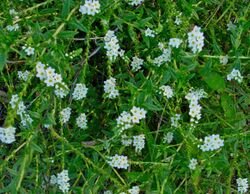Biology:Euploca
| Euploca | |
|---|---|

| |
| Euploca salicoides | |
| Scientific classification | |
| Kingdom: | Plantae |
| Clade: | Tracheophytes |
| Clade: | Angiosperms |
| Clade: | Eudicots |
| Clade: | Asterids |
| Order: | Boraginales |
| Family: | Boraginaceae |
| Subfamily: | Heliotropioideae |
| Genus: | Euploca Nutt.[1] |
| Type species | |
| E. convolvulacea Nutt. | |
| Synonyms[2][3] | |
| |
Euploca is an almost cosmopolitan genus of plants with around 100 species.[3] It was first described by Thomas Nuttall in 1837.[1][4] While part of the broadly defined Boraginaceae in the APG IV system from 2016,[5] a revision of the order Boraginales from the same year includes Euploca in the separate family Heliotropiaceae.[3] Its species used to be classified in the genera Hilgeria and Schleidenia and in Heliotropium sect. Orthostachys, but were found to form an independent lineage in a molecular phylogenetic analysis, more closely related to Myriopus than to Heliotropium.[2] While many species use the C4 photosynthetic pathway,[6] there are also C3–C4 intermediate species.[7][8] Species have leaves with a C4-typical Kranz anatomy.[2]
Selected species:
- E. convolvulacea Nutt. (sweet-scented heliotrope, showy heliotrope)
- E. filiformis (Lehm.) J.I.M.Melo & Semir
- E. fruticosa (L.) J.I.M.Melo & Semir
- E. greggii (Torr.) Halse & Feuillet
- E. humilis (L.) Feuillet
- E. ovalifolia (Forssk.) Diane & Hilger
- E. polyphylla (Lehm.) J.I.M.Melo & Semir
- E. procumbens (Mill.) Diane & Hilger
- E. pulvina (Craven) Diane & Hilger
- E. salicoides (Cham.) J.I.M.Melo & Semir
- E. strigosa (Willd.) Diane & Hilger
- E. tenella (Torr.) Feuillet & Halse
References
- ↑ 1.0 1.1 "Tropicos – Euploca Nutt.". 2018. http://www.tropicos.org/Name/40007178.
- ↑ 2.0 2.1 2.2 Hilger, H.H.; Diane, N. (2003). "A systematic analysis of Heliotropiaceae (Boraginales) based on trnL and ITS1 sequence data". Botanische Jahrbücher 125 (1): 19–51. doi:10.1127/0006-8152/2003/0125-0019. ISSN 0006-8152.
- ↑ 3.0 3.1 3.2 Luebert, F.; Cecchi, L.; Frohlich, M.W.; Gottschling, M.; Guilliams, C.M.; Hasenstab-Lehman, K.E.; Hilger, H.H.; Miller, J.S. et al. (2016). "Familial classification of the Boraginales". Taxon 65 (3): 502–522. doi:10.12705/653.5. ISSN 0040-0262. https://www.researchgate.net/publication/304454062. Retrieved 16 June 2018.
- ↑ Nuttall, T. (1837). "Collections towards a flora of the territory of Arkansas". Transactions of the American Philosophical Society. New Series 5: 189–190. OCLC 2382293. https://biodiversitylibrary.org/page/35957894.
- ↑ Angiosperm Phylogeny Group (2016). "An update of the Angiosperm Phylogeny Group classification for the orders and families of flowering plants: APG IV". Botanical Journal of the Linnean Society 181 (1): 1–20. doi:10.1111/boj.12385.

- ↑ Sage, R.F. (2016). "A portrait of the C4 photosynthetic family on the 50th anniversary of its discovery: species number, evolutionary lineages, and Hall of Fame". Journal of Experimental Botany 67 (14): 4039–4056. doi:10.1093/jxb/erw156. ISSN 0022-0957. PMID 27053721.

- ↑ Vogan, P.J.; Frohlich, M.W.; Sage, R.F. (2007). "The functional significance of C3–C4 intermediate traits in Heliotropium L. (Boraginaceae): gas exchange perspectives". Plant, Cell & Environment 30 (10): 1337–1345. doi:10.1111/j.1365-3040.2007.01706.x. ISSN 0140-7791. PMID 17727423.

- ↑ Sage, R.F.; Christin, P.-A.; Edwards, E.J. (2011). "The C4 plant lineages of planet Earth". Journal of Experimental Botany 62 (9): 3155–3169. doi:10.1093/jxb/err048. ISSN 0022-0957. PMID 21414957.

Wikidata ☰ Q17414548 entry
 |

